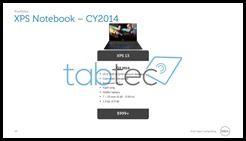 We’re in a good place with Ultrabooks right now. Haswell gave us the battery life we were waiting for and prices have come down. Effectively the Ultrabook project is over but the brand, and the soul of the Ultrabook continues. A Dell XPS13 has been leaked for Q3 and it’s highly likely we’ll see a launch at Computex in June but don’t expect any large-scale products or refreshes until Q4. While some may say that’s a slip, it was much the same with the last generation.
We’re in a good place with Ultrabooks right now. Haswell gave us the battery life we were waiting for and prices have come down. Effectively the Ultrabook project is over but the brand, and the soul of the Ultrabook continues. A Dell XPS13 has been leaked for Q3 and it’s highly likely we’ll see a launch at Computex in June but don’t expect any large-scale products or refreshes until Q4. While some may say that’s a slip, it was much the same with the last generation.
With Broadwell we can expect another tick (or was it a tock?) in the Intel strategy of improving processor architecture and then improving the manufacturing process. This time round we’re moving to a 14nm process which, like the move from Sandy Bridge to Ivy Bridge, gave us power efficiencies. We also got a refreshed GPU in that round too so maybe we’ll see some ‘Iris’ action on Ultrabooks later this year.
Given that there has been little talk about an Ultrabook standard this year you’re going see products that range from $400 to $4000 and build on their own brands and unique selling points. We expect Intel to try and encourage OEMs to use the Realsense 3D camera technology and we thing that fanless Core-based tablets and 2-in-1s could be a common feature this year. With more efficiency comes two options. Either the OEM takes the SKU with the increased clock rate to offer more performance for the same battery life or they take a similar powered processor and reduce the battery size. For the mainstream market you can expect the latter.
Don’t expect budget Ultrabooks in Q4 though because Y-series and Pentium-branded options may not appear until 2015, at least according to one report.
Other features and keywords to look out for in 2014 are:
- Dual-OS: We expect some 2-in-1 solutions to offer Dual-OS. This is something for the mainstream market and is likely to be promoted as ‘all your Android games, but better.’ Or something along those lines.
- Perceptual Comnputing: That’s Realsense 3D cam technology and voice assistance.
- Wireless Display: We expect a push on WiDi / Miracast.
Tip: Softpedia











Is “Dual-OS” the term being used on the Internet for Windows and Android OS’s on a single device? I’d prefer desktop Linux distro and Windows on a single device where it means the OEM has contributed to making Linux work with it like Dell.
Dell Linux patches have made it upstream. I’m looking forward for more from Dell (except that that horrid XPS 11).
If battery size is reduced does it automatically mean lower weights?